|  
IN THE NEWS | FROM THE PUBLISHER | CALENDAR
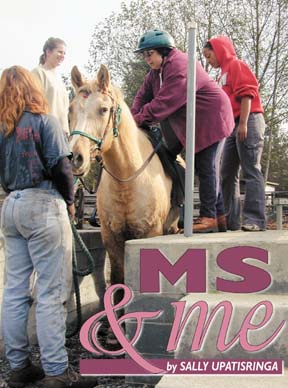
by SALLY UPATISRINGA
IT CAME SO SILENTLY, THE WAY CARL SANDBURG'S FOG CREEPS IN on little cat feet. It came and never left and life changed forever. The years that followed became a time of giving up. First racquetball fell by the wayside, then workouts at the gym and finally the stationary bicycle. Long walks were replaced with shorter walks, followed by the necessity of walking with a platform cane. Today, walking alone is limited to indoors. As hands became clumsy with numbness, quilting no longer offered pleasure. Enjoying the art of others is a mixed blessing. It's wonderful to hold fabric to my face and enjoy the feel of varied textures. Counting stitches in a just-completed quilt and talking patterns with a friend is special. It still hurts, though, knowing that that part of life is over. It's hard, feeling old and limited when I am still in my forties and accustomed to creating and living my own lifestyle. July 1997 and the Jones family reunion at the Box R Ranch is in full swing. In the mountains east of Ashland, the Box R is a favorite retreat for my mother's family. This day is muggy and soon there will be flashes of lightning and the crashing of thunder followed by heavy summer rain. The heat makes it impossible for me to do much of anything so I am content to lie on the bed and read and nap. I'm also enjoying eavesdropping on the conversations others are having on the deck outside my bedroom window. In the early afternoon there is still no rain but there is a new voice coming from the living room. Sharon, the wrangler from the Box R, has come to tell us about the riding lessons and trail rides that are available. The three youngest children and their fathers head for the corral. The children return from their adventure just ahead of the rain. They are bursting with stories of horses and saddles and learning to ride forwards and in reverse. Sharon is a good teacher, they tell us, and she knows the names of all the horses and they, horses and children, listen to her and do what she tells them to do. One father allows that the horses understand directions much better than the children! 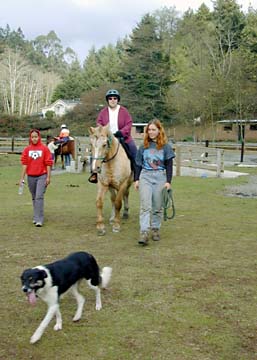 The reunion is over and my husband Vis and I have returned to Pine Lodge, our vacation home on this beautiful mountain. It is cool here, and quiet after all the activity of the weekend. I like to sit on the deck and listen to the wind in the pine trees. There are books to read, cards, dominoes and music. I enjoy them all. However, no matter what I do, not far from the surface, there is the memory of the children and their horse stories. The reunion is over and my husband Vis and I have returned to Pine Lodge, our vacation home on this beautiful mountain. It is cool here, and quiet after all the activity of the weekend. I like to sit on the deck and listen to the wind in the pine trees. There are books to read, cards, dominoes and music. I enjoy them all. However, no matter what I do, not far from the surface, there is the memory of the children and their horse stories.
I love horses. I love everything about them -- the way they smell, their velvety noses, the magical way they communicate with their ears. I always wanted a horse of my own but in my father's words, "A horse doesn't produce anything." And he was correct. An animal that requires so much food and care is a luxury. In the past, once in a great while an opportunity to ride would come along and I would climb on, hold on and hope for the best. All in all, however, it was never very satisfactory. But if there is a horse gentle enough for 7-year-old Danny, would that same horse be gentle enough for me? I wonder. Multiple sclerosis has taken a toll on my body and I find it difficult to maneuver even shallow steps with my legs feeling like sacks of cement. The very idea of me on a horse is laughable, but there it is! I want to ride that horse -- any horse. Perhaps I could just sit on a horse? To ride or not to ride has become a question that only I can address and so I will ask the wrangler for advice. Sharon listens to my request. It is a rather fractured recital and shaky because I am so afraid that the answer will be no. But when I finally get the question out, her response is, "Let's do it." No hemming and hawing, no rolling of eyes -- just, "Let's do it." And so we do! Sharon has found a large wooden box for me to use as a step. I stand on the box and her helper stands next to me, ready to lift my leg up and over Amigo. Sharon stands at the horse's head, reins in hand. Amigo just stands calm and cool. I love him already. Lifting my leg up and over is not easy and the helper apologizes profusely over the need to give my butt a shove. I take it all in good humor and try to help him do the same. Nevertheless, he is embarrassed and I remind myself that, after all, he is a teenager. At last, I'm on a horse, sitting tall in the saddle. The moment of absolute joy is quickly gone because now I must do something -- make the horse go forward or backward, something. I will soon learn that one of Sharon's favorite teaching techniques is to ask her students, "Who's driving, you or the horse?" For a while, my answer will be, "the horse." But in the meantime I sit there, grinning from ear to ear and thinking, "This is ever so much better than racquetball!" I'm wearing borrowed boots that don't quite fit. I need a box and a shove on the butt in order to get on, but who cares? Sharon, is smiling, too, as she leads Amigo and me to the ring. Now for the hard part, do what the teacher tells me to do. Please God, let this be all right. Don't let me fall off. Don't let me embarrass myself. Don't let me hurt Amigo. This is so exciting. Thank you. "We don't have to do this, Sharon." I'm perched on the platform that seems to have appeared overnight after it became obvious that using a box to mount and dismount was of questionable intelligence. There are two steps to the platform that has been built between two trees, and a railing on two sides. I'm sitting on the railing watching Sharon lead Amigo to the ramp. On the other side of the ramp, in order to make a lane for the horse to walk through, Sharon has placed, upside down, a large metal watering trough. Amigo does not want to walk through this lane, much less stop and let me get on. Sharon takes Amigo through the lane again and again. Amigo does not change his mind. I begin to feel guilty. After all, I don't have to learn to ride. Amigo is sweet and gentle and he will enjoy letting me brush him and feed him carrots. Deep inside, however, is that small voice of total honesty that says, "I want to ride that horse!" Sharon's response to "We don't have to do this" is unexpected. She tells me that a horse wants to do what is asked of him. He just needs to be treated with respect and kindness. She is right. Soon Amigo enters the lane and stands quietly, even when Sharon climbs on top of the watering trough and jumps up and down, making a hellish noise. The time is now. All the waiting and working and praying and finger-crossing is over. Sharon stands at the horse's head and I, leaning forward and holding tight to the saddle horn, get my left leg (yes, the left leg, my strongest) over the saddle and I am on. The beginning is over. Each day finds me at the Box R Ranch ready for a lesson. I work in the small arena. I learn how to stop and go, how to change directions and how to ride up to a line drawn in the dirt and stop. When I don't stop in time, Sharon says, "Oops, you fell over the cliff. You're dead." And then I try again. I have five, maybe six lessons and then on a wintry October afternoon Sharon and I take our longest ride, up the road to the big house, through the beautiful meadow and back to the ranch. This is Sharon's last day at the Box R. Soon all the horses will be taken to their homes. Soon I too will go home to Eureka and take up the threads of my normal life, whatever that means. Except, life will never be the same. Every day and every night I will remember and celebrate those days of lessons and that last wonderful ride. I will yearn for a return to the freedom that being on horseback has come to mean. Sharon is not at the Box R Ranch in the summer of 1998 but a new wrangler is and I drive over to introduce myself. Randy knows about me and tells me that Amigo is ready to ride. Amigo! He's back and ready to ride! Nichole, our 14-year-old niece, is spending a few weeks with us and she is almost as excited as I am. We hurriedly sign release forms, find helmets that fit and head for the ramp. I will be on Amigo and Nichole will ride Bodry. Nichole and I do some work in the arena and then, with Randy walking ahead of us, we take a short ride to the old immigrant cemetery. I have never visited the cemetery because it is an uphill walk on uneven terrain. This day I don't have to stay behind and later listen to someone else's description of the trail (part of which is the historic Applegate Trail), the cemetery, the critters they saw, and the fun they had. Now it is my turn to experience all those things and I do and in my soul I hear the words, "This is the day the Lord hath made; let us rejoice and be glad." Amigo had been a little reticent about standing at the ramp while I mounted and now he refuses to stand there while I dismount. In fact, he plunges backward, throwing me and then falling and rolling on my legs. Randy rushes to pull me out from under the horse. Amigo scrambles up and away and Randy helps me to a sitting position before going to find something for me to sit on. I rest awhile before I get up and walk around, checking to make sure nothing is broken or otherwise damaged. Randy decides that in the future, Nichole will ride Amigo and I will ride the more mellow Bodry. It is a good decision and under Randy's kind tutelage the two of us bloom. Mornings find us at the Box R Ranch. I brush Bodry by standing close to him while leaning on my platform cane. This little exercise helps us get to know one another. While he is being saddled I stand at his head, scratching his face and talking to him. Once mounted, I become just another student learning to be a horsewoman. Randy works gently but firmly, and gradually I learn to drive my horse passably well. In the ring Bodry and I make figure eights around small cans that have been set out by Randy. As the lessons progress, the cans are placed closer and closer together and all three of us celebrate when Bodry and I complete the course with no misses. This beautiful summer of riding includes excursions to many places. The immigrant cemetery is always a favorite destination. As I sit in the saddle and look down on that small plot of land, I think about the men and women and children whose sense of adventure led them to this special land. Our great-grandfather and his widowed mother were part of that great migration and they homesteaded right here, on Box R land. Longer trips take us up into the rocks to marvel at the volcanic work completed how many eons ago. One trail allows us a view of Mount Shasta, that mystical, cloud-shrouded mountain that towers over all of Siskiyou County. Now I begin to learn in earnest. There is so much to know. Before the workday begins, the horses are watered, fed, groomed and saddled. It is a social time, if you will, allowing horses and humans to welcome one another to the new day. Horses are not saddled for the entire day. When there is a length of time between rides, they are relieved of the heavy burden of tack. 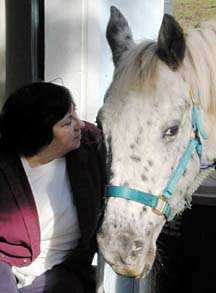 In October of 1998 I buy a horse of my very own! Lucy is a leopard appaloosa, beautiful to look at and beautiful to ride. [photo at right] Lucy understands very quickly that I am not your average beginner; I have some special disabilities and she, Lucy, must take those disabilities into account if we are going to make this partnership successful. She understands and a beautiful relationship is born. In October of 1998 I buy a horse of my very own! Lucy is a leopard appaloosa, beautiful to look at and beautiful to ride. [photo at right] Lucy understands very quickly that I am not your average beginner; I have some special disabilities and she, Lucy, must take those disabilities into account if we are going to make this partnership successful. She understands and a beautiful relationship is born.
Lucy stays on the mountain when winter comes, but I go home to Eureka. I miss her and call Sharon often to inquire after her. Christmas finds us at Pine Lodge and Sharon rides Lucy over for a visit. Because of winter snow, Lucy is not wearing horseshoes and we agree that I will not ride. Instead, I brush her and feed her apples and she responds by rubbing her head against me. Her winter coat is very heavy but I worry anyway and offer to send her a horse blanket. Sharon, horsewoman and mountain resident, smiles and assures me that Lucy's coat is coat enough. The next spring arrives and suddenly I own a second horse, Stella, a palomino. [photo below left] During our many quiet times together, Sharon and I had talked about my need for a second horse, since it's impractical for me to ride alone. Stella is bossy and soon she is the dominant horse. She eats and drinks first while Lucy stands back, waiting patiently for her turn. Nichole and I are back on the mountain. A portable corral is installed at Pine Lodge and Lucy and Stella come to spend the summer. How exciting it is to have our horses just outside the door. Sharon spends nights with us and I am grateful to her because frankly, I know little about horses and I worry that a crisis will happen at 2 o'clock in the morning! 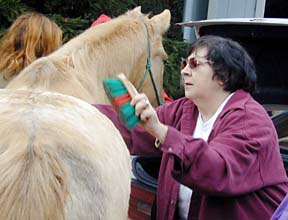 Sharon and Nichole build a hitching post next to the deck and the horses are tied there when we groom and saddle them. Lucy learns to stand at the deck so that I can mount and dismount. Every morning Nichole gets up at 6:00 and staggers out to feed and water the horses and then stumbles back to bed. I guess this disease has some perks after all because when I hear Nichole get up to do chores, I just snuggle down under the covers and go back to sleep. Sharon and Nichole build a hitching post next to the deck and the horses are tied there when we groom and saddle them. Lucy learns to stand at the deck so that I can mount and dismount. Every morning Nichole gets up at 6:00 and staggers out to feed and water the horses and then stumbles back to bed. I guess this disease has some perks after all because when I hear Nichole get up to do chores, I just snuggle down under the covers and go back to sleep.
We ride in the cool of the morning and sometimes again in the evening. The heat makes me very ill and mid-day finds me in the living room surrounded by fans. Nichole is in charge of the horses and she does a wonderful job of keeping the water troughs full, scooping poop and keeping the corral clean. Sometimes Nichole and Sharon ride together while I'm staying cool. One day Nichole is surprised to find that she has learned to canter. She grows in confidence and self-reliance and becomes a treasured companion. When Nichole leaves, the horses are taken to their winter pasture. My heart hurts as I watch the trailer take them away. Now it is my turn to leave. Back in Eureka, Vis and I talk about stabling Stella and Lucy on the North Coast. Vis, who is not particularly fond of horses, is amenable to the idea. He has watched the change in me as I have discovered a new life with horses and he likes and encourages that change. There is just one big question. Where will I find a place with stables, ramps for mounting and dismounting, someone to ride with me, help me on and off and take care of the horses as well? Deep in the recesses of my mind is the sliver of a memory of a place called Camelot. Pursue that sliver, a little voice tells me. I do and I find Camelot and this Camelot is in Trinidad. Camelot is the home of Doug and Nancy Jager. Doug loves horses; Nancy does not, but together they have created a magical place for folks like me. The 4-H Trail program was born in 1985. There are paddocks, a wheelchair-accessible mounting ramp, an arena, trails and horses, several of them large gentle Norwegian fiords. Everyone who participates in the program is a volunteer and everyone belongs to 4-H. The volunteers do many things scoop poop, groom horses, clean tack, repair equipment, etc. Their most important role, however, is to help clients ride. Every rider has a headwalker who has a lead rope attached to the horse's bridle so she will be in control. These 4-H volunteers have special training and strong people and horse skills. Sidewalkers walk along on either side of a rider, one hand resting on the person or horse as needed. Riders start every ride in the arena where they are encouraged to try many things -- stretching exercises, following commands, playing games. Sometimes a fiord is fitted with a circingle, a large pad with handles but no stirrups. All manner of exercises are designed to make stiff muscles more limber, loosen joints, teach independence and confidence. And it's all accomplished under the guise of having fun! One visit to Camelot and I know that this is the place. Doug and Nancy's daughter, Sally, is now an integral part of the program and we have a long talk about me and my horses. On a cold and drizzly day, Stella and Lucy arrive at Camelot. Vis and I hurry over to see them. The trip from Ashland was long and the horses are tired and confused and very happy to hear a familiar voice -- mine. Within a few weeks they are settled in and I am ready to begin a new odyssey in this wonderful world of horses, one so close to home I can venture north every weekend all year round to that magical place called Camelot.
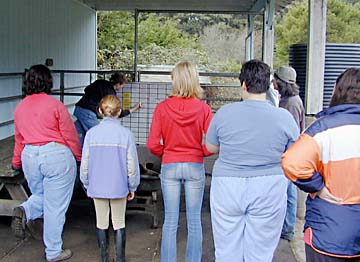
Sally Friedley fills in the assignment board as the 4-H volunteers wait for their instructions. 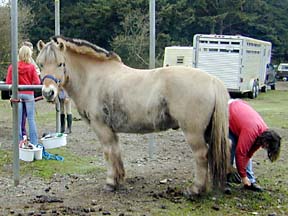
A large gentle Norwegian fiord named Christoff is groomed before being saddled up for riding. 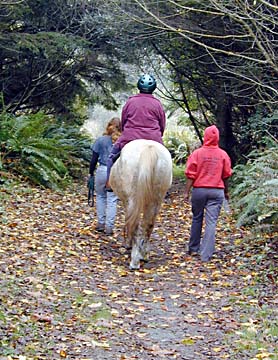
Upatisringa rides Stella along the trail with her headwalker, Natalie Herman, and sidewalker, Sara Beyene.
A horseman helps the disabled -- and himself
by KEITH EASTHOUSE 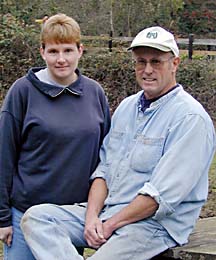 LIKE MANY PEOPLE, DOUG JAGER USED TO FEEL UNCOMFORTABLE around those who were physically or mentally handicapped. LIKE MANY PEOPLE, DOUG JAGER USED TO FEEL UNCOMFORTABLE around those who were physically or mentally handicapped.
"I would try and ignore them, look the other way. It took a lot of maturing and developing for me, but now these guys are my friends." Sitting out in the November sunshine at Camelot, his 6-acre spread in Trinidad, Jager smiled briefly. A large outdoorsy man of 62, Jager has ridden horses since he was a teenager and seems the picture of health. But he's got his own physical problem, polyneuropathy, a disorder of the nervous system that has interfered with his ability to detect sensation and maintain his balance. [Doug Jager at right in photo, with daughter Sally Friedley on the left] "It's like having your body encased in a glove," Jager said, explaining that if he were to put his hand on a hot stove, he would be able to feel it, "but not until I was burned deeply." As for his balance, it's fine as long as it's daytime or he's in a well-lighted place where he can see. In the dark it's a different story, for the simple reason that there's no horizon to orient himself. "If it's dark, I'm in trouble. I need to use my eyes." Looking back on it, he sees now that the condition was coming on in the 1980s, but it wasn't diagnosed until the 1990s. So it had nothing to do with his decision 17 years ago to open up his 4-H Trail program to handicapped kids and adults. Jager, a retired professor emeritus of forestry and watershed management at Humboldt State University, became a 4-H leader in 1977, when his daughter Sally was 10 (4-H does not allow kids to ride until that age). A Trinidad woman helped him out with the program, which basically involved teaching kids to ride and care for horses and take part in competitions. In 1985 she dropped out, giving Jager an opportunity to take things in a different direction. 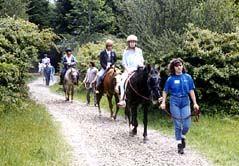 "I wasn't keen on dragging kids to horse shows," he recalled, so when a colleague at HSU mentioned a program in Australia in which disabled kids rode horses as therapy, Jager decided to do something similar. "I wasn't keen on dragging kids to horse shows," he recalled, so when a colleague at HSU mentioned a program in Australia in which disabled kids rode horses as therapy, Jager decided to do something similar.
"It seemed like a nice thing to do," Jager explained. "My wife and I and our kids were very fortunate. We hadn't had these sorts of problems and this was a way for us to help out people who weren't as lucky." The deceptively simple act of riding a walking horse provides an array of benefits to the handicapped. For someone in a wheelchair, riding stimulates muscles that would normally be used for walking and so helps prevent them from atrophying. Those with cerebral palsy are prone to having their hips and knees lock together; horseback riding stretches muscles in those areas and can allow someone to avoid the standard surgery to correct the problem -- cutting the muscles on the inside of the legs. Finally, climbing onto a horse offers a psychological boost. "If you're in a wheelchair, you're always looking up at people. On a horse, you don't have to do that," Jager said. A few years back, Jager had to mount a fight when the 4-H organization, concerned about liability issues, decided that it was no longer going to continue to exempt his program from the restriction that a child had to be 10 years old to get on a horse. Jager wrote a paper on the value of getting disabled kids up on a horse as early as age 2 or 3; collected a sheaf of letters from parents and physicians saying the same thing; and made a verbal presentation to 4-H officials. It took awhile, but he eventually persuaded the organization to reinstate the exemption. Today the program is going strong and currently serves about 20 handicapped people. Jager said twice as many could be involved if he could find more volunteers (if you're interested, contact him by e-mail). As for Jager, his disease, a degenerative condition, is slowly gaining the upper hand. He has problems with pain and insomnia and he doesn't ride as vigorously as he used to. If he lives long enough, he could end up in a wheelchair. Jager imparted this information matter-of-factly, with no hint of complaint or self-pity. "There are lots of people out there worse off than I am," he said. Then he said something else, something that showed that the disabled kids and adults he's worked with over the years have taught him about coping. "It's the abilities they have that are important, not the disabilities," he said.
IN THE NEWS | FROM THE PUBLISHER | CALENDAR Comments? E-mail the Journal: [email protected] 
© Copyright 2002, North Coast Journal, Inc. |